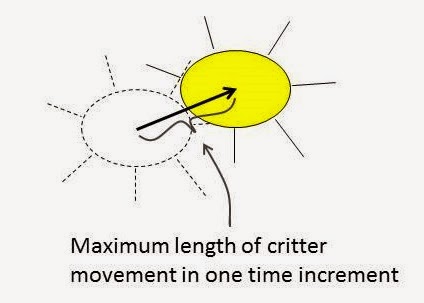We imagine a world which is a flat surface, a little section of tabletop works well. On the tabletop we find little living things which we call critters. We might think of critters as single-celled organisms, but their size is not particularly important.
Preliminary List of the Properties of Critters
What is important is that these critters have certain properties which we would associate with living things. (The following list is adopted for critters from the general case for Living Things which was described in this post.)
- The critters can survive only if they get adequate nutrients, water and sugar. Fortunately there is some water and sugar available in this environment, about which we will learn more later.
- The critters can sense their immediate surroundings, noticing if they are nearby to water, sugar, or another critter.
- The critters have a memory and can use it together with sensory inputs to decide (to calculate based upon some rules) upon an act to attempt.
- The critters can act in various ways. They can move about. They can consume water or sugar that they find within reach. They can reproduce by dividing when their internal reserves of water and sugar are adequate.
- The critters have motives, they try to survive and to accumulate internal stores of water and sugar to improve their chances of reproducing.
- Time passes in this world and for the critters we model the passage of time in increments. In each time increment a critter can attempt to perform only one act. First, before that attempt, the critter senses its surroundings and internal conditions, then it searches in its memory to see if it has ever encountered similar conditions. It "thinks" as well as it can with the mind we have specified for it. Finally, it decides which act from among its capabilities to attempt.
- In each increment of time a critter's body consumes some of its stores of water and sugar. The critter dies if one of these stores runs out.
 |
| Symbols representing the three types of objects in our world |
Additional Properties of Critters
As I have worked with this model, trying to make it run in computer code, I have continually discovered more properties which I had to specify in order to make the model achieve what I hope. One property is the distance a critter may move in each time increment. It may move a distance roughly equal to the diameter of its body (the yellow oval).
 |
| Critter movement |
A critter may move in each time increment in any direction in the plane provided its body does not collide with anything, a resource or another critter's body. In order to preserve the visual clarity of the model, objects are not allowed to pile on top of each other in the plane.
 |
| Critter sense area inside dotted oval |
A critter can attempt to consume a resource which it can sense in its sense area. It is not necessary that the critter move closer, for the purpose of consumption, so its body is adjacent to the resource. A critter cannot consume a resource outside its sense area. In the picture above the critter can attempt to consume the sugar but not the water.
A critter does not always accomplish what it decides to do. In each increment of time it decides upon an action to undertake, then it attempts that action. But larger fate determines whether and how much the critter's attempt succeeds. For example two critters may move in one time increment to where both can sense a single water drop. Both may decide to consume the whole drop with their next act.
 |
| Critters cannot always succeed in their attempted actions |
The Initial Condition
We start with an initial condition in which a small population of critters just barely survives by foraging for water and sugar. There is no steady and certain source of water or sugar. Instead a small portion of water or sugar appears now and then, randomly dropped into the world. These resources come as gifts from fate perhaps, or are carried in by the wind. In any case the critters' only hope of survival comes from moving about almost continuously in hope of encountering water or sugar. The critters are hunter-gatherers. Death because of starvation for either water or sugar is their most common fate. But fate can also be good sometimes. Sometimes a critter finds enough water and sugar to enable it to reproduce. So the population hangs on — barely. In our initial condition the population of critters is near the maximum that the environment can sustain, given the rate of influx of resources.
 |
| Initial condition: critters foraging randomly |
This completes our description of the initial condition in the model of tabletop critters. In a later post we will see changes in which the critters start to live richer lives. The images will remind us of prosperity which can grow in human communities, as I will try to convince you.
No comments:
Post a Comment